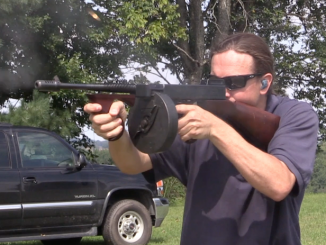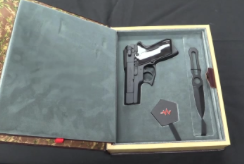This rifle is lot #1386 at Morphy’s April 2019 auction.
James Paris Lee is known today as the inventor of the detachable box magazine, and the “Lee” in the “Lee Enfield” rifle system – a very significant contributor to firearms development. His first foray into the business of gun design and manufacture, however, was a rather ignominious failure.
Lee patented a single shot swinging barrel system in 1862, and hoped to win an Army contract for it. In February of 1864 he submitted a rifle version to the Army, and was promptly rejected – the Army was not interested in breechloading rifles. Lee came right back in April 1864 with a carbine pattern, and this was accepted for testing – the Army was indeed looking for breechloading cavalry carbines. It took a full year, but in April 1865 the Army came back and gave Lee a contract for 1,000 carbines at $18 each. Lee rounded up investors and capital, and created the Lee Fire Arms Company in Milwaukee to produce the guns. His first two samples were delivered in January 1866 – in .42 rimfire caliber.
At this point, there is some disagreement. Lee claims that his sample guns in .42 caliber were accepted, and thus his followup delivery of .42 caliber carbines should have been accepted. The government said that the contract specified .44 rimfire caliber, and his delivery of .42 caliber guns was unacceptable, and thus rejected. A court case would ensue, but with the rejection of the first 250 guns and the cancellation of their contract, the company had to look hard and fast for a backup plan. In March 1867 newspaper ads were placed in Milwaukee for sporting rifles and carbines from the Lee company. The parts planned for military production were used instead for civilian guns in a variety of configurations – carbines, light rifles, and heavy rifles in several barrel lengths and several calibers. By 1868 all production had ceased, and the Lee Fire Arms Company dissolved.
James Lee returned to his former profession of watchmaking, but this experience with gun manufacturing would not keep him deterred for long. By 1872 he was back working with Remington, and would go on the produce the designs that we know him for today. The lessons of this rifle? Firearms manufacturing is a risky business, not for the faint of heart. And also, sometimes you can learn from a difficult experience to do better the second time.




Great history. Learned much. Particular praise for the use of “datum” in the presentation. Warms my heart that among some of us nerds, “data” is still the plural known.
Ah, yes, lost vocabulary. I won’t burgle your thunder, but people of the next generation are becoming illiterate through willful ignorance.
It is no understatement to say that Ian improved my English skills more than most of my teachers did back in school.
that is a pretty neat gun, I could see this one modernized with an automatic ejector and stronger barrel and it would make a really good “first” gun.
The modern (better I think) version of this concept is the “Handi-Rifle” by H&R/New England Firearms. Remington now owns H&R and they no longer sell accessory barrels (for example I have 3 for one rifle: .223, .357 Mag., and 12 ga) they break open and extract or extract&eject (depends on barrel model) and are inexpensive, durable, and accurate. See http://www.hr1871.com/Firearms/Rifles/youth.asp.html
If at first you don’t succeed… try again after getting more expertise?
“(…)Firearms manufacturing is a risky business, not for the faint of heart. And also, sometimes you can learn from a difficult experience to do better the second time.(…)”
I would say that this is example of how important is correct communication i.e. one not omitting relevant details – like in this case cartridge used. Even if it only looks like 0.02 inch. This reminded me about monthly meeting of staff from Slovak embassy with staff of Slovenia embassy, during which letters are sorted, as some individuals have odd habit of replacing SLOVENIA with SLOVAKIA or inversely in address:
http://www.slovak-republic.org/slovenia/
Regarding these .42 rim-fire and .44 rim-fire cartridges: what were their actual case dimensions? how big was powder charge?
The last line is a pertinent question, I wish to know the answer too. At that time apparently any maker could create their own new caliber, as long as ammo was on stock.
Assuming this gun has rifled bore it would not be possible to just open up bore by 0.02″(0.5mm); since grooves were about half of that value, there would be nothing left out of them.
“(…)0.02″(…)”
Taking in account that 19th century U.S. cartridge manufacturers were chaos-worshipers in area of naming (one example: .38 S&W and .38-55 and .38-40 all seem to be same caliber, where in reality differ in caliber*) I would be more careful in assuming that.
Considering than then used bullets were crafted from plumbum (or strictly speaking alloys with plumbum being main ingredient) which is malleable it should be possible to add tapered cone at breech end of barrel (c.f. forcing cone as found in revolvers firing metallic cartridges, though in this case its main job was positioning of bullet rather than making its diameter smaller), so bullet would be squeezed to right diameter. Naturally rifling would be lost at that part of barrel, however it would also mean tighter fit at rest of barrel length.
Therefore I suspect that difference between actual bullet diameters was greater or .44 has actually much greater powder charge, meaning this weapon could not harness it safely.
* diameter of bullet.
Right, “chaos worshipers” is fitting term. Yeah it is a mess. Standard sizes such as 0.375″, 0.406″ and 0.438″ make sense to me though (I’ve gotten used to it in first few years here, although Canada had been officially metric already then). That would be lot easier to remember.
Yes, in N/A custom, the bullet size which ideally coincides with groove to groove size is standard (or should be). In practise the bullet is 0.001/0.002″ bigger to assure tight fit. Jacket gets elongated; if there is no jacket it is even easier.
Btw. you use name “plumbum” as far as name for element (I believe “svinets” in Russian). In common English it is “Lead”.
jacketed bullets are dead on bore size, lead or plated bullets are ~.01″ over bore
Did not Lee also design the Lee Navy rifle or is that a different Lee?
James Paris Lee was involved in development of “1895 Lee Navy” according to:
https://www.forgottenweapons.com/biography-james-paris-lee/
I distinctly remember President Lincoln telling me he wanted it in 56-56 Spencer
Very elegant design, excellent machining and fit. This is all what is needed for basic rifle/ carbine.
Always read the contract!
And do your best to understand it and to comply with it.
If you are the one who is writing the contract, it always helps if you slip a “Brown M&Ms clause” or three in there.
Then you have timely warning if the other party to the contract hasn’t read the contract or hasn’t understood what is required from them.
Lee does seem to have been a litigious individual. He later went after both Mauser and Mannlicher, alleging that they had infringed upon his patent for the box magazine.
That interaction between the barrel and the hammer is very clever. It doubles as an out of battery safety 🙂